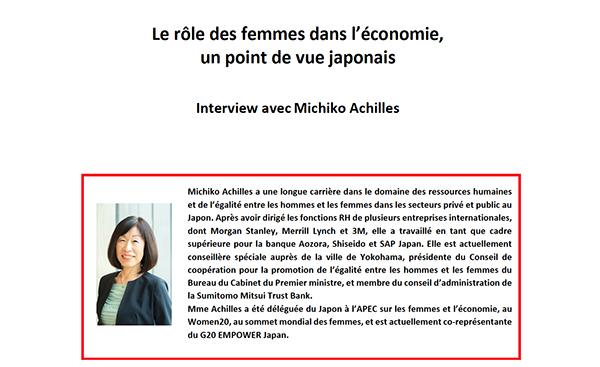The role of women in the economy, a view from Japan
Japan Program
Michiko Achilles,
March 13, 2023
Ms. Achilles has an extensive career in human resources and gender equity in Japan’s private and public sectors. After leading HR functions for several global companies, including Morgan Stanley, Merrill Lynch and 3M, she worked as an Executive Officer for Aozora Bank, Shiseido and SAP Japan. She is currently a Special Advisor to the City of Yokohama, the Chair of the Gender Equality Promotion Cooperation Council of the Cabinet Office, and a Board Director of Sumitomo Mitsui Trust Bank. Ms. Achilles was a delegate of Japan to the APEC on Women and Economy, Women20, the Global Summit of Women, and is currently a Co-representative of G20 EMPOWER Japan.
Question 1: During Covid-19 many women left the workforce in Japan. Can they be brought back and why should they?
Many did and many came back. By March 2022, the women’s employment rate had recovered to the level before Covid-19. Japan faces a structural shortage of workers due to the declining working-age population, which peaked in 1990 and is expected to decrease by 29.2 percent from the 2021 level by 2050“Gender Equality White Paper 2022”, Gender Equality Bureau, Cabinet Office, Japan.. Companies need diligent and capable workers, regardless of gender. To attract and retain workers during the Covid-19 period, many companies started to offer flexible work arrangements, such as remote work. This means workers do not have to spend time commuting. Working parents find this particularly helpful to better balance their work and private lives.
Question 2: What are the main obstacles Japan faces?
One of the main obstacles is an insufficiently diverse workforce, particularly at decision-making levels. The ratio of women executives in Japan increased by 4.8 times over the past nine years, but it is only 7.5 percent, which is one of the lowest ratios among OECD countriesNational Women Education Center, Japan.. In politics, the ratio of women members is 14.4 percent in the Diet (2022) and only 15.1 percent in local assemblies (2021)Online survey on Lifestyle 2021 by MaVie Ltd., Japan.. This means that in corporate and political worlds, important decisions are made by a majority of men and a few women, despite the fact that more than half of the population is made up of women. The root cause is old values and expectations, which define conscious and unconscious gender roles. In the government’s survey on gender equality in 2019, asked about gender equality throughout society, 74.1 percent of women responded that men are given privileged treatment.
Question 3: Is there a future for Womenomics in Japan?
Definitely there is a future for womenomics, a policy launched by former PM Abe to increase the role of women in the economy. Women will be a key to economic growth in Japan in multiple ways. The reason is that there are many well educated (51.6 percent of female high school graduates entered universities in 2021, versus 54.3 percent of male graduatesNational Women Education Center, Japan.) and capable women in Japan. At another level, 80 percent of purchasing decisions in households are made by womenOnline survey on Lifestyle 2021 by MaVie Ltd., Japan. and 52.6 percent of women (only 28.1 percent of men) live to the age of 90 or more in Japan“Gender Equality White Paper 2022”, op. cit..To lead a positive “100-year life”, women need to be economically independent, which creates a huge market for all kinds of services and goods. If we can have more women in decision-making positions in the private and public sectors, we can cater to the women market and society in general more effectively. Also, we need a diversity of people working together to innovate. Women are the biggest diverse group, and we cannot afford underutilizing their talent.


The role of women in the economy, a view from Japan
Michiko Achilles, March 13, 2023